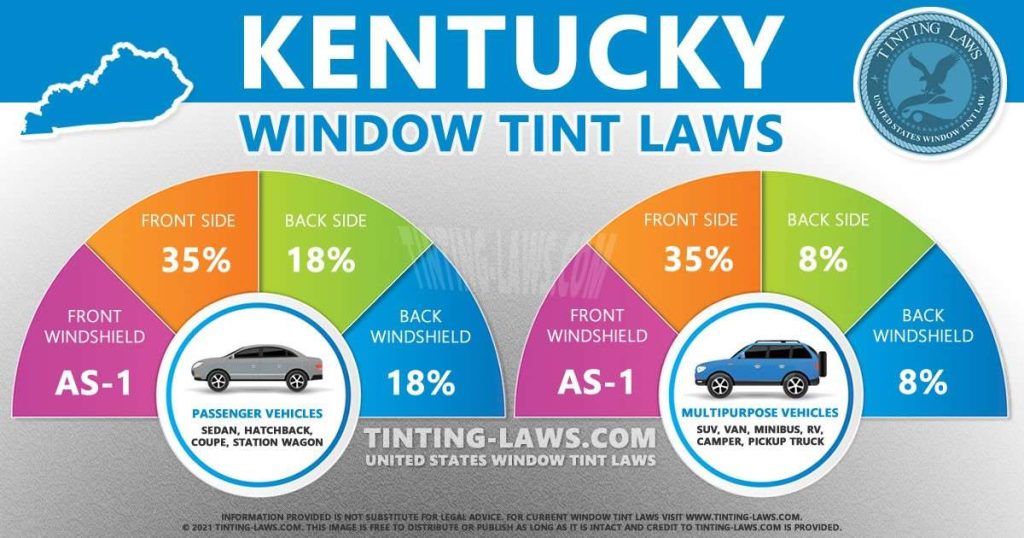Kentucky Window Tinting Laws
Car window tinting laws in Kentucky were enacted in 1994.
We have provided all the necessary information about your car’s window tint, including how dark or reflective the tint is allowed in your state.
There are also additional car window tinting rules and regulations in Kentucky so make sure you read all about it below.
Window tint darkness in Kentucky
The percent of visible light allowed through your car windows is called VLT: Visible Light Transmission.
The percentage of light allowed through your film and glass in Kentucky is very specific and different for sedan cars and SUV cars or vans.
Tint darkness for sedans:
- Windshield: Non-reflective tint is allowed above the manufacturer’s AS-1 line.
- Front Side windows: Must allow more than 35% of light in.
- Back Side windows: Must allow more than 18% of light in.
- Rear Window: Must allow more than 18% of light in.
Tint darkness for SUV and vans:
- Windshield: Non-reflective tint is allowed above the manufacturer’s AS-1 line.
- Front Side windows: Must allow more than 35% of light in.
- Back Side windows: Must allow more than 8% of light in.
- Rear Window: Must allow more than 8% of light in.
Window tint reflection in Kentucky
Window tint can reflect incoming light and reduce glare and heat.
Kentucky window tint law permits a certain window reflection when using a tint so make sure you pay attention to this as well.
Tint reflection for sedans:
- Front Side windows: Must not be more than 25% reflective.
- Back Side windows: Must not be more than 35% reflective.
Tint reflection for SUV and vans:
- Front Side windows: Must not be more than 25% reflective.
- Back Side windows: Must not be more than 35% reflective.
Other Kentucky window tint rules and regulations:
Kentucky does have several other important laws, rules and regulations pertaining to window tinting. They include the following:
- Side Mirrors: Dual side mirrors required if back windshield is tinted.
- Restricted Colors: No specific tint colors are prohibited.
- Tint Variance: 3% variance allowed.
- Certificates: Manufacturers of film need to certify the film they sell in the state. Consult with your dealer to make sure they are using certified film.
- Stickers: The sticker to identify legal tinting is required on the inside of the driver’s side doorjamb.
- Medical Exceptions: Kentucky law does NOT allow medical exemptions that would allow you use special tint.
- Penalties: Class B misdemeanor.
Keep in mind that Kentucky tinting laws and regulations may be interpreted differently in your county or place of residence.
We always recommend double-checking our information with your local DMV or law enforcement authorities.

Our information about window tint laws in Kentucky was last updated in 2024.
Tinting laws in Kentucky were enacted in 1994.
In case any of our info provided is not up to date or correct be sure to contact us so we can fix it. Thanks!
Trusted industry leader in providing accurate window tint laws. Share with confidence:
State of Kentucky Info
Kentucky, officially the Commonwealth of Kentucky, is a state located in the east south-central region of the United States.
Kentucky is one of four U.S. states constituted as a commonwealth (the others being Virginia, Pennsylvania, and Massachusetts).

Originally a part of Virginia, in 1792 Kentucky became the 15th state to join the Union. Kentucky is the 37th most extensive and the 26th most populous of the 50 United States.
Capital: Frankfort
Population: 4,380,415
Area: 40,409 sq mi (104,659 km2)
Cities in Kentucky: Louisville, Lexington, Bowling Green, Paducah, Frankfort, Owensboro, Elizabethtown, Bardstown, Bearville, Covington, Hopkinsville, Essie, Richmond, Pikeville, Ashland, Florence, Danville, London, Sweeden, Berea, Middlesborough, Somerset, Corbin, Harlan, Erlanger, Murray, Lowes, Maysville, Shelbyville, Glasgow, Nicholasville, Relief, Newport, Georgetown, Fies, Hazard, Madisonville, Shepherdsville, Henderson, Campbellsville, Dingus, Hebron, Benton, Eminence, Winchester, Cave City, Morehead, Versailles, Raceland, Harrodsburg
Counties in Kentucky: Adair, Allen, Anderson, Ballard, Barren, Bath, Bell, boone, Bourbon, Boyd, Boyle, Bracken, Breathitt, Breckinridge, Bullitt, Butler, Caldwell, Calloway, Campbell, Carlisle, Carroll, Carter, Casey, Christian, Clark, Clay, Clinton, Crittenden, Cumberland, Daviess, Edmonson, Eliott, Estill, Fayette, Fleming, Floyd, Franklin, Fulton, Gallatin, Gerrard, Grant, Graves, Grayson, Green, Greenup, Hancock, Hardin, Harlan, Harrison, Hart, Henderson, Henry, Hickman, Hopkins, Jackson, Jefferson, Jessamine, Johnson, Kenton, Knott, Knox, LaRue, Laurel, Lawrence, Lee, Leslie, Letcher, Lewis, Lincoln, Livingston, Logan, Lyon, McCracken, McCreary, McLean, Madison, Magoffin, Marion, Marshall, Martin, Mason, Meade, Menifee, Mercer, Metcalfe, Monroe, Montgomery, Morgan, Muhlenberg, Nelson, Nicholas, Ohio, Oldham, Owen, Owsley, Pendleton, Perry, Pike, Powell, Pulaski, Robertson, Rockcastle, Rowan, Russell, Scott, Shelby, Simpson, Spencer, Taylor, Todd, Trigg, Trimble, Union, Warren, Washington, Wayne, Webster, Whitley, Wolfe, Woodford
Tint law references:
Kentucky Revised Statutes section 189.110: Unobstructed windshields. (PDF file)